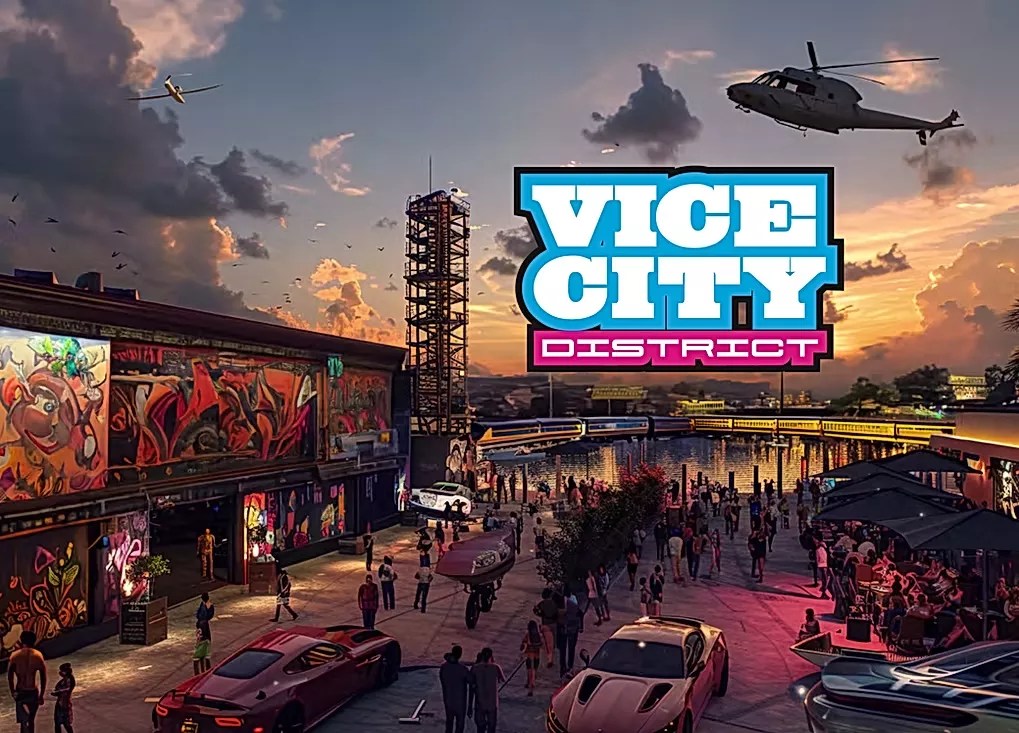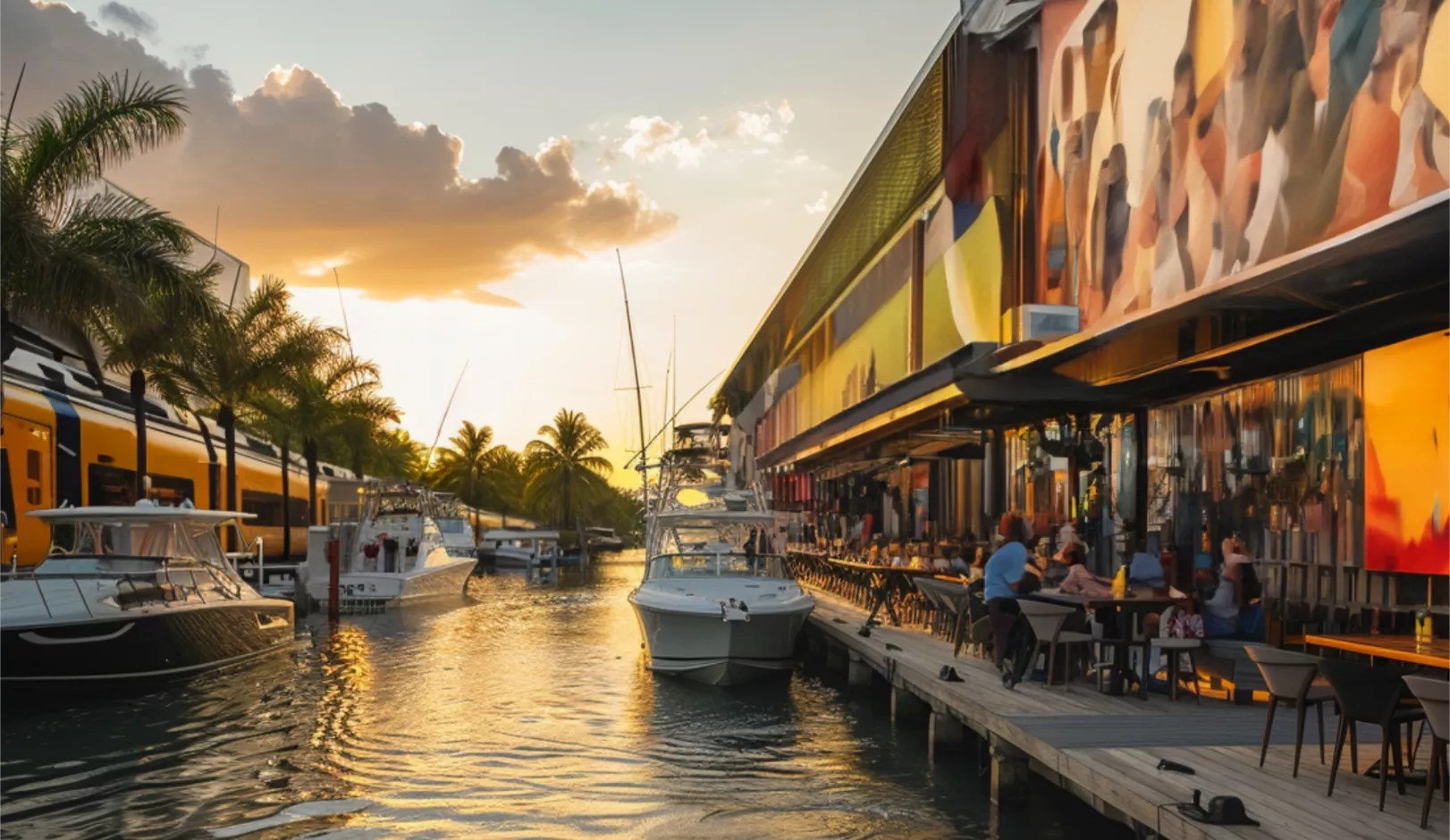
Photo by Zulekha Pitts

Audio By Carbonatix
In September, when New Times published Theo Karantsalis’ feature story, “Boatyard Brouhaha,” a small parcel at 471 NE 79th St. in Miami’s Little River neighborhood seemed on the verge of an extreme makeover.
The site, a former boatyard and small marina, was to become a museum and retail complex called the Uplands. Emancipator 471, a limited liability company helmed by prominent local developer Avra Jain, would honor Miami’s maritime history while championing ecological balance.
In documents submitted to state environmental agencies, Jain proposed reducing the number of boat slips on the property from 21 to eight and restoring the boatyard and marina to convert it into “a dining, shopping, historic experience” and a “safe, secure, and environmentally responsible marina for boaters and visitors to Miami.” (Her LLC borrowed its name from the parcel’s 1940s incarnation as the Emancipator Boatyard, home base of S. Mortimer Auerbach, who designed a renowned wooden racing boat he dubbed the Emancipator.)
But Jain’s vision didn’t sit well with wary neighbors and environmental advocates, who feared the project would disrupt the Little River, a haven for manatees and a rare enduring reminder of Miami’s pre-urban past.
Despite multiple attempts on the part of the story’s author, Jain repeatedly stymied requests for specifics about her plans, instead pointing to features like on-site water collection – a form of green infrastructure that would prevent rainwater or water used by the business from draining directly into the Little River – and sidestepping questions with responses such as, “People who know me know the kind of work I do. I want to revive Little River’s story.”
Nearly four months later, not much seems to have changed. The Uplands project remains on the drawing board, and Jain has not responded to multiple requests for an update on its status.
However, one of the boatyard’s current tenants has his own plans for the disused boatyard, a bold concept he calls Vice City District.

The future of Little River looks like a scene straight out of Miami Vice meets Grand Theft Auto. Vice City District promises a bold mix of nostalgia, luxury, and cutting-edge entertainment in the heart of Miami.
Vice City District graphic
A mix of luxury, 1980s nostalgia, and environmental consciousness, the alternative reinvention is the brainchild of XXXX Elo, a resident of the tiny nearby municipality of El Portal.
Karantsalis interviewed Elo while reporting his story in August. The British entrepreneur effused about Vice City and showed off a set of renderings featuring heavy neon embellishment and a Miami Vice-inspired color palette. Karantsalis was already familiar with the images, which had circulated among the aforementioned neighbors and environmentalists, fueling their skepticism and alarm. When he asked Jain about the renderings, she acknowledged that Elo was a tenant at the boatyard but disavowed any connection to her Emancipator plans, saying the drawings pertained to a car storage space Elo operated in Wynwood. “He made a marketing brochure for his business with cars and glam,” she said.
“Boatyard Brouhaha” made no mention of Elo or his incipient vision.
Bold Vision for a Boatyard
Elo arrived in Miami from England in 2014. By Miami Art Week in 2015, he had launched Supercar Rooms, touting it as the world’s first “road art” gallery and promising to redefine Magic City’s experience of automotive and artistic spaces.
“I wanted to create something unique,” he says now.
Supercar Rooms operated for nearly a decade in Wynwood. When its lease expired in July, Elo had the cars, many of them relics of pop culture history, transported to Jain’s property on NE 79th Street, where the collection would form an essential element of Vice City District.
“They’re more historical cars – every car has a story,” Elo explains. “Some of them are cars that are used in movies. So people go, ‘Oh, my God, that’s the car in Fast & Furious!'”
He also owns a white 1986 Ferrari Testarossa, which he says Don Johnson’s character, Sonny Crockett, acquired in Season 3, Episode 2 of Michael Mann’s iconic 1980s TV series Miami Vice.
“For the 40th anniversary, we had that car do all the 40th-anniversary stuff with all the old actors,” Elo says. “And that’s what we want to do,” he adds. “I have the DeLorean from Back to the Future and a bunch of other cars.”
But this is no luxury car rental operation, he clarifies. His Vice City District is all about evoking nostalgia. “It’s not like we’re trying to rent cars for people to, you know, drive them. We just use the cars to create a time, a moment, a nostalgia feel.”
To Elo, Vice City District isn’t just about showcasing cars – it’s about creating an immersive, almost gamified experience for visitors, mixing Miami Vice nostalgia with a Grand Theft Auto vibe.

Envision a serene evening at Vice City District’s waterfront dining area, where boats dock horizontally along the canal, ensuring aquatic life like manatees can pass through safely.
Vice City District graphic
“I want the experience to feel more like a game. When you come in, you go into what I call the Vice City Bank,” Elo elaborates. “You get tokens. You get the Vice City dollars. So you basically have a currency within the world of Vice City.”
Elo emphasizes that he wants to build on the layered history of the Emancipator property.
“This building has seen so many uses,” he notes, tracing the property’s roots back to its days as a strawberry warehouse in 1919 before Auerbach’s arrival. “That’s why you see Emancipator LLC,” he adds. “Because they used to build Emancipator boats here, cigarette boats that race.”
His plans for Vice City District include a gallery showcasing iconic supercars and vintage motorcycles and a host of interactive experiences. Futuristic AI services will also enhance waterfront dining, entertainment, and a members-only lounge.
“It’s not going to be a museum,” Elo stresses. “It’s going to be an area where people can come in, have fun, and get away from the chores of everyday life.”
The goal? To create a space that connects Miami’s past to its future.
“I want to save the Miami of the ’80s, but I want to merge it with Gen Z,” he says. “I want to play Phil Collins, but I also want to play Taylor Swift.”
Is It Criticism, or Is It Bias?
Elo views Vice City District as a destination that would fill in the gaps left by Miami’s entertainment hot spots.
“Wynwood is getting too touristy,” he points out. “Now, the only businesses that work there are restaurants and bars. Design District? If you’re not carrying a bag, you look like a thief. People are walking around you. Security is chasing you. It’s uncomfortable.”
Little Havana, Elo allows, retains its charm.
“I like it a lot,” he reflects. “But we don’t have that. Little Haiti is just not really picking up. I really would like that to pick up. I heard the Magic City [Innovation] District will change that.”

At the 2023 Amelia Concours d`Elegance, XXXX Elo hangs with rapper and producer Wyclef Jean in the Attucks Apex AP0.
XXXX Elo photo
In fact, he says, he’d hoped to establish his project in Little Haiti, but the logistics didn’t pan out.
“That’s where I originally wanted to go. And then there were just no locations. Everything there has been carved up and bought already. Developers are sitting on all of that because they want to go vertical, you know.”
With Vice City District, Elo says, he wants to fill in what Miami’s missing: a cool hangout where people can gather, connect, and escape the monotony of cookie-cutter nightlife.
Elo says he intends to plant mangroves and restrict boat traffic to nonmotorized activities like kayaking and paddleboarding to protect Little River’s ecosystem.
“We’re taking responsibility to make sure this looks amazing,” he asserts. “We want people to engage with nature while still respecting it.”
He envisions boats aligning with the river’s character, steering clear of anything that would disturb its balance.
“I want the vintage boats, the vintage-style boats, not the big yachts,” he explains. “There’ll be the boats that were meant for that river. The only boats that can go up and down that river are single 20-foot boats.”
Critics have voiced concerns about the project’s proximity to a manatee protection zone. Elo acknowledges the environmental challenges but emphasizes his vision for coexisting with the area’s natural inhabitants.
“I would like to have flamingos because that’s a picture of Miami that I saw when I was a kid. The flamingos on the bay flying out,” Elo shares. “Like in El Portal, we have peacocks. I want the peacocks there. I want the iguanas. I want all the wildlife. I want us to live in harmony with the wildlife.”
While navigating these ecological concerns, Elo points to an unspoken layer of scrutiny.
“People see a Black guy like me fronting the project, and they’re like, ‘Oh, my God! There goes hip-hop. There goes the neighborhood,'” he says. “They start saying, ‘We need to keep the area the way it was.’ We’re all for that – but we also want to make it better.”
Noting that he signed a ten-year lease with Emancipator, Elo reiterates, “The vision I have for this building will be very much in line with community wellness and social integration.”
The Silent String-Puller
Avra Jain, who spearheaded the development plans for the property, remains involved in the Emancipator project and Vice City District but seems intent on remaining behind the scenes. New Times‘ recent attempts to reach her for comment have gone unanswered or parried with scheduling conflicts.
Elo, however, praises her preservation efforts along the Biscayne Boulevard corridor in the area known as the Upper Eastside and the MiMo (shorthand for the Miami Modern style of architecture) District.
She’s all for everything,” he says. “Avra owns most of the properties and hotels here. She could’ve built high-rises, but instead, she preserved Miami Modern. She’s done such a great job.”
As for the project’s current status, questions remain about the bureaucratic side of things. Elo clarified that Jain and Emancipator LLC are communicating with all parties regarding revitalizing the area.
“I have no direct information about the current situation. I know it’s ongoing,” Elo says.
Nearly a decade after Supercar Rooms’ debut, Elo had intended to make a splash with Vice City District during Miami Art Week. But he forwent the splash and instead hosted a private art-meets-fashion event to celebrate Supercar Rooms’ decade in Miami, focusing on supporting local arts and building community engagement.
Avra Jain’s ultimate word on Elo’s vision for the Emancipator property remains to be heard. Regardless, the transformation of this small, historic parcel hidden on the banks of the Little River behind the Sabor Tropical shopping plaza embodies the potential – and the associated tensions – of Miami’s ever-evolving identity.